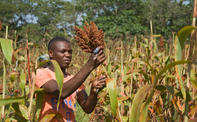
Sorghum does not require irrigation but should be planted when the soil is moist. It performs better than maize during drought. It may be cultivated in rotation with a legume crop (such as cowpeas) benefiting from the nitrogen provided by the legume.
Sorghum grows in both high and low rainfall areas and should be planted between 2.5 cm (a finger width in heavy soil) to 5 cm (in sandy soil) deep. Sorghum is tolerant of pollutants and can thrive in toxic soils that kill most plants.
Sorghum is sensitive to viral and bacterial diseases that may result in low yield and poor quality, however, it can be controlled using disease-free seeds and resistant cultivars. Also monitor sorghum for Chilo borer, maize stalk borer, aphids, and bollworm.
Harvesting Sorghum
Pasturing is the cheapest method of harvesting forage - animals can help themselves!Mechanical harvesting is best to harvest sorghum for silage, but when harvesting the grains it can be done by hand and the heads are dried on the ground or threshing floor. If the whole plant is cut, leave it in the field to mature for 10 - 14 days and thresh it to separate the seeds from the husks.
Seeds should be sorted - to clean it from stones, insects and other foreign matter - before it is packed.
Store dry, packed tightly and keep away from animals or insects.
Green matter yield may vary from 20t/ha to 75t/ha under ideal conditions.
Sorghum grain is graded according to malting quality and is available as food, malt or feed sorghums.By Marinda Louw